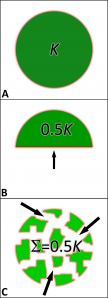 This last post before Easter is something I’ve thought more and more about over the last few years. I wouldn’t have given it much time in the past, but I’m now convinced roads are one of the humanity’s most destructive devices. Let me explain.
This last post before Easter is something I’ve thought more and more about over the last few years. I wouldn’t have given it much time in the past, but I’m now convinced roads are one of the humanity’s most destructive devices. Let me explain.
Before I had a good grasp of extinction dynamics, I wouldn’t have attributed much import to the role of roads in conservation. I mean, really, a little road here and there (ok, even a major motorway) couldn’t possibly be a problem? It’s mostly habitat destruction itself, right?
Not exactly. With our work on extinction synergies, I eventually came to realise that roads are some of the first portals to the devastation to come.

Figure 1. (A) A large population within unmodified, contiguous habitat fluctuates near full carrying capacity (K). (B) When habitat is reduced (e.g. 50% area loss), total abundance declines accordingly. (C) All remaining fragmented subpopulations have limited connectivity, implying much greater extinction risk than that predicted for the same habitat loss in less fragmented landscapes.
It sort of works like this (see Fig. 1 from our paper in Trends in Ecology and Evolution). Instead of destroying habitats (forests, reefs, grasslands, savannas, etc.) systematically (i.e., in large, contiguous blocks – Fig. 1B), we tend to fragment landscapes into many disconnected patches (Fig 1C). The vehicle by which we do this in terrestrial (especially forest) ecosystems is with roads connecting the matrix. As in turns out, instead of reducing biodiversity by the proportion of primary habitat lost (in this case, by 50 %), the multi-patch type of fragmentation leads to a much larger proportional biodiversity loss. This is because of the interactive effects of piecemeal fragmentation: roads between patches facilitate human and other predator access to areas previously isolated, micro-climatic changes resulting from a high proportion of ‘edge’ habitats can alter suitability, and invasive species have many more pathways by which they can spread.
But the role of roads in extinctions has long been recognised. I’m probably most familiar with Bill Laurance‘s work on Amazonian roads being responsible for massive fragmentation in the tropics. It also so happens that there’s an entire field of ‘road ecology research’ that probably didn’t even register on most conservation radars prior to the last few decades.
The reason I’m raising this topic now is that I’ve just stumbled across an interesting online paper in Trends in Ecology and Evolution by Lesbarrères1 & Fahrig entitled Measures to reduce population fragmentation by roads: what has worked and how do we know? And these Canadians should know a thing or two about road-driven habitat fragmentation – Canada has now some of the most fragmented portions of the boreal forest, with < 40 % of its area considered ‘contiguous’ (i.e., not bisected by roads).
The authors talk about so-called ‘ecopassages’, which have been put in place in many road developments to mitigate wildlife ‘conflict’, such as crossing structures (bridges, underpasses, etc.) that are supposed to link habitats bisected by roads too difficult to cross safely for most species. Their main point is, however, that most of these lack any real scientific rigour in either testing their effects (do they actually work?), or even planning them from the outset. The authors go on to give a detailed description about how road developments should design transportation networks with wildlife connectivity in mind prior to building, and that rigorous scientific protocols should be developed to test their effectiveness. Fair cop.
However true these pleas and recommendations are, I still think the paper misses the main point (and it has a decidedly North American bias) – why do we need so many roads in the first place? Indeed, in most places in the world now, finding primary habitats is difficult enough, so surely we can be a bit cleverer about putting fewer roads in places where they are not strictly needed?
The point is that roads are generally very bad, not just because they impede connectivity, but because they open up a Pandora’s box of conservation nightmares still to come. Still, forcing road-network planners to consider these issues pre- and post-development can only do good.
CJA Bradshaw
–
1Interesting to note that this surname is remarkably close to ‘les barrières’ in French, meaning ‘barriers’ or ‘fences’. How appropriate!

